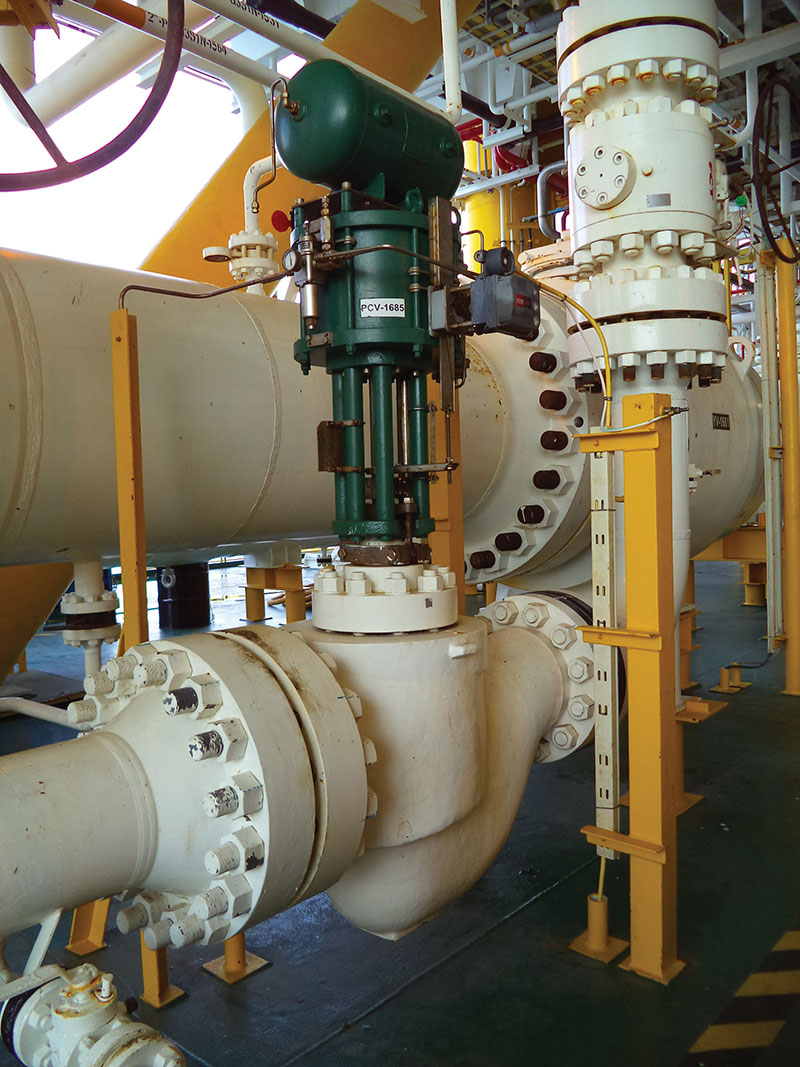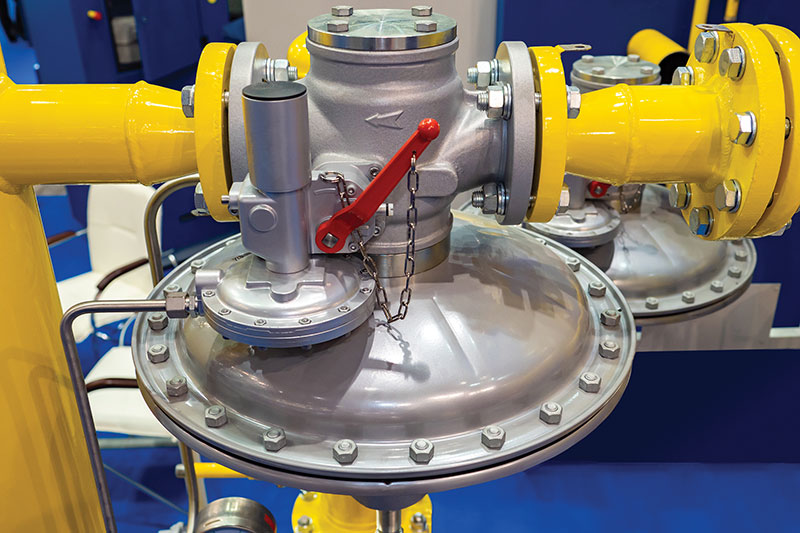July 2020, Vol. 247, No. 7
Metering and Measurement
Using Pressure Regulators for Site Distribution in Natural Gas Pipelines
By Paul Baker, Senior Mechanical Engineer, Jacobs
The codes covering higher-pressure natural gas distribution systems are CFR-2011, Title 49, Volume 3, Part 192, Transportation of Natural and Other Gas by Pipeline: Minimum Federal Safety Standards, and ASME B31.8, Gas Transmission and Distribution Piping Systems.
Although these codes may not be specifically applicable to campus distribution systems, they offer many guidelines on pipe material selection and regulator selection that would apply to best-practice designs for these smaller systems. Unfortunately, ANSI Z223.1/NFPA 54, National Fuel Gas Code and the International Fuel Gas Code, do not get into these areas of system design in great detail.
I recommend working closely with the natural gas supplier and follow its rules, regulations and recommendations for installation since the supplier will be most familiar with the local rules applicable to the project. These will have precedence over the gas transportation and transmission codes.
CFR Title 49, Part 192, covers most overland natural gas piping systems, excluding gathering pipelines.
ASME B31.8 covers all natural gas piping from gathering piping near the gas wells to distribution piping. On the downstream end, its scope ends just beyond the outlet of the customer’s meter/regulator set assembly where ANSI Z223.1/NFPA 54 or the International Fuel Gas Code takes over.
Both codes refer to 60 psig (414 kPa) in the design of natural gas distribution systems. There is one set of rules for systems operating over 60 psig and another set of rules for systems operating under 60 psig.
Keep in mind that the piping material and wall thicknesses are based on the expected maximum operating pressure of the piping system. The boundary between high-pressure systems and low-pressure systems has to do with the design of pressure-regulating stations.
Starting Point
The purpose of the codes is to provide a basis of design for the pipeline and all the components connected to the downstream system, including valves, control valves, regulators, meters, pressure vessels and other components connected to the piping system. The pressure-regulating station provides a “break” in the system where the new pressure design can control all the downstream system parameters.
Upstream of the pressure-regulating station, the plumbing engineer has no control over the pressure but needs to confirm with the natural gas supplier what conditions can be expected at the inlet to his site or his regulating station. In many cases, the natural gas supplier provides the regulating station and the owner would only be responsible for the natural gas distribution system downstream of the pressure-regulating station.
The maximum operating pressure is not determined by the set-point of the regulator, but by the safety pressure-relieving system while it is operating at full flow. So, when the owner’s representative is interviewing the site’s natural gas supplier, he would need to have the supplier provide the following information for the natural gas pressure regulators:
- set-point (winter)
- set-point (summer, if different from winter set-point)
- relief valve set-point
- maximum outlet pressure at full relief pressure
- natural gas specific gravity and higher heating value at standard conditions
- all rules and recommendations applicable to the installation in the location of the project
The natural gas supplier needs to provide the minimum expected pressure at the site entrance if the supplier’s regulator is located remote from the project site and another regulator is selected for the site’s entrance.
The owner would then determine the pressure drops for the natural gas distribution system from the gas supplier’s gateway to the project’s building entrance, considering the peak loads for all other buildings that might be used on the system simultaneously.
When designing the natural gas distribution systems, older federal design guidelines recommended using the summation of the peak loads for the first 15 buildings connected to the system and only then taking an 80% diversity for all additional loads.
Overpressure Protection
As mentioned, ASME B31.8 covers the natural gas piping upstream of the owner’s natural gas system where ANSI Z223.1/NFPA 54 or the International Fuel Gas Code takes over.
Generally, the regulators in the customer’s building may be very low pressure. Regulators covered under ANSI Z223.1/NFPA 54 include the following.
Gas appliance pressure regulator. This regulator controls pressure to the appliance manifold and is normally furnished with the appliance. Commonly, appliance regulators reduce the pressure of 5 to 8 inches water column (w.c.) (1.25 to 2.0 kPa) down to a manifold pressure of 3.5 inches w.c. (0.87 kPa). This pressure will likely be higher for large boilers and industrial furnaces. Appliance regulators are required to be listed in accordance with ANSI Z21.18/CSA 6.3, Gas Appliance Regulators.
Line pressure regulator. This regulator is placed in a gas line between the service regulator and the appliance regulator. A line pressure regulator is required when the gas supply pressure exceeds the maximum allowable inlet pressure of the appliances served. Line pressure regulators are required when the pressure drop between the service regulator and the appliance is expected to be 1 inch w.c. (0.25 kPa) or more.
Line pressure regulators are installed where the inlet pressure is between 14 inches w.c. (3.4 kPa) to 5 psig (34 kPa) and the downstream appliance requires a lower inlet pressure. Line pressure regulators are required to be listed in accordance with ANSI Z21.80/CSA 6.22, Line Pressure Regulators, where the outlet pressure is set to 2 psi (14 kPa) or less.
- Monitor regulator: A pressure regulator installed in series with another pressure regulator to prevent overpressure in the downstream piping system.
- Series regulator: A pressure regulator in series with one or more other pressure regulators.
Service regulator. This pressure regulator is installed by the serving natural gas supplier to reduce and limit the service line gas pressure to delivery pressure required at a building entrance. For a typical residence or small commercial building, the pressure is reduced from up to 60 psig to down to 2 psig or less.
The device is usually located outdoors and directly upstream of the meter. Service pressure regulators are required to be listed in accordance with AGA ANSI B109.4/CSA 6.18-M95, self-operated diaphragm-type natural gas service regulators, where the outlet pressure is set to 2 psi (14 kPa) or less and the nominal pipe size is 1.25 inches (32 mm) and smaller.
It is important for the plumbing engineer to understand the pressure limitations of the downstream system. In some cases, the pressure could be 2 psig (14 kPa) or less, 5 psig (34 kPa) or less or a higher pressure. The system designer needs to review the regulator specification and selection of the downstream regulators, particularly the certified maximum inlet pressure [2, 5 and 10 psig (14, 34 and 69 kPa) are standard ratings] and the emergency exposure limits [up to 65 psig (450 kPa)].
Generally, natural gas pressures inside buildings are normally limited to 5 psig (34 kPa), unless the building is a warehouse, industrial complex or one of the other circumstances outlined in the codes.
Inlet Pressure
If the maximum allowable operating pressure of the distribution system for domestic, small commercial and small industrial customers exceeds 60 psig (410 kPa), suitable methods are required to regulate and limit the pressure of the gas delivered to the customer to the maximum safe value. Such methods may include ASME 845.2.7(c); CFR 192.197(c).
If the service regulator with characteristics listed for inlet pressures are less than 60 psig and a secondary regulator is located upstream from the service regulator, the secondary regulator must be set to maintain a pressure of 60 psig or less. A device is required to be installed between the secondary regulator and the service regulator to limit the pressure on the inlet of the service regulator to 60 psig or less in case the secondary regulator fails to function properly.
This device may be either a relief valve or an automatic shut-off that shuts off if the pressure on the inlet of the service regulator exceeds the set pressure and remains closed until manually reset. [ASME 845.2.7(c)(1); CFR 192.197(c)(1)].
Directions for a service regulator and a monitoring regulator set to limit the pressure of the gas delivered to the customer to a maximum safe value can be found in ASME 845.2.7(c)(2); CFR 192.197(c)(2).
So that the pressure of gas going to the customer does not exceed a maximum safe value, a service regulator with a relief valve must be vented to the outside atmosphere, with the relief valve set to open. The relief valve can be either built into the service regulator or may be a separate unit installed downstream from the service regulator.
This combination may be used alone only in cases when the inlet pressure on the service regulator does not exceed the manufacturer’s safe working pressure rating of the service regulator. It is not recommended for use when the inlet pressure on the service regulator exceeds 125 psig (860 kPa). For higher inlet pressures, the methods a or b listed above should be used. [ASME 845.2.7(c)(3); CFR 192.197(c)(3)].
The code for a service regulator and an automatic shutoff device that closes upon a rise in pressure downstream from the regulator and remains closed until manually reset can be found in CFR 192.197(c)(4).
Control, Limiting
For the situations listed below, the following codes contain the information relevant to controlling and limiting pressure:
- If the maximum allowable operating pressure of the distribution system is 60 psig (410 kPa) or less, and a service regulator having all the following characteristics is used, no other pressure-limiting devices are required. [ASME 845.2.7(a); CFR 192.197(a)]
- A pressure regulator capable of reducing distribution line pressure, psig (kPa), to pressures recommended for household appliances, inches (millimeters) of water column. [ASME 845.2.7(a)(1); CFR 192.197(a)(1)]
- A single port valve with an orifice diameter no greater than that recommended by the regulator manufacturer for the maximum gas pressure at the regulator inlet. [ASME 845.2.7(a)(2); CFR 192.197(a)(2)]
- A valve seat made of resilient material designed to withstand the abrasion of the gas, impurities in gas and cutting by the valve, and designed to resist permanent deformation when it is pressed against the valve port. [ASME 845.2.7(a)(3); CFR 192.197(a)(3)]
- Pipe connections to the regulator not exceeding NPS 2 (DN 50). [ASME 845.2.7(a)(4); CFR 192.197(a)(4)]
- The capability under normal operating conditions of regulating the downstream pressure within the necessary limits of accuracy and of limiting the buildup of pressure under no-flow conditions to no more than 50% over the normal discharge pressure maintained under flow conditions [ASME 845.2.7(a)(5)]; or pressure that would cause the unsafe operation of any connected and properly adjusted gas utilization equipment. (CFR 192.197(a)(5))
- A self-contained service regulator with no external static or control lines. [ASME 845.2.7(a)(6); CFR 192.197(a)(6)]
If the maximum allowable operating pressure of the distribution system is 60 psig or less and a service regulator not having all the characteristics listed above is used, or if the gas contains materials that could seriously interfere with the operation of the service regulators, suitable protective devices shall be installed to prevent unsafe over-pressuring of the owner’s appliances should the service regulator fail.
Some of the suitable types of protective devices to prevent over-pressuring of the customers’ appliances are as follows [ASME 845.2.7(b); CFR 192.197(b)]:
- a monitoring regulator [ASME 845.2.7(b)(1)]
- a relief valve [ASME 845.2.7(b)(2)]
- an automatic shutoff device [ASME 845.2.7(b)(3)]
These devices may be installed as an integral part of the service regulator or as a separate unit.
Pressure Limitation Requirements (NFPA 5.9.2)
Where piping systems are serving appliances designed to operate with a gas supply pressure of 14 inches w.c. (3.4 kPa) or less are required to be equipped with overpressure protection, each overpressure protection device shall be adjusted to limit the gas pressure to each connected appliance to 2 psig (14 kPa) or less upon a failure of the line pressure regulator or to a pressure as required by the appliance manufacturer’s installation instructions.
Each overpressure protection device installed to meet these requirements shall be capable of limiting the pressure to its connected appliance(s) as required by this section independently of any other pressure control equipment in the piping system.
Each gas piping system for which an overpressure protection device is required by this section shall be designed and installed so that a failure of the primary pressure control device(s) is detectable.
If a pressure relief valve is used to meet the requirements of this section, it shall have a flow capacity such that the pressure in the protected system is maintained at or below the limits specified above/under the following conditions: the line pressure regulator for which the relief valve is providing overpressure protection has failed wide open or the gas pressure at the inlet of the line pressure regulator for which the relief valve is providing overpressure protection is not less than the regulator’s normal operating inlet pressure.
Overpressure protection devices are required to be one of the following: pressure relief valve, monitor regulator, series regulator installed upstream from the line regulator and set to continuously limit the pressure on the inlet of the line regulator to the maximum allowable values, or automatic shut-off device installed in series with the line pressure regulator and set to shut off when the pressure on the downstream piping system reaches the maximum allowable values. This device shall be designed so that it will remain closed until manually reset.
Selection Process
When selecting a regulator or a series of regulators or a regulator with a relief valve, provide the following information to the regulator supplier:
- regulator design flow rate (SCFH or nm3/hr; 100% to 120% of connected capacity is normal)
- regulator pressure set point (psig or kPa-gauge)
- maximum inlet pressure (psig or kPa-gauge)
- minimum inlet pressure (psig or kPa-gauge)
- maximum outlet pressure (psig or kPa-gauge)
- natural gas specific gravity (S.P. air = 1)
- local project altitude or local atmospheric pressure (psia or kPa-absolute)
Author: Paul Baker is a senior mechanical engineer with Jacobs in Fort Worth. A graduate of Lehigh University in 1975, he has more than 40 years’ experience in the HVAC and plumbing fields. He has been an ASPE member since 2006.








Comments